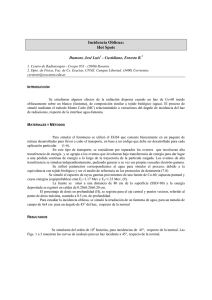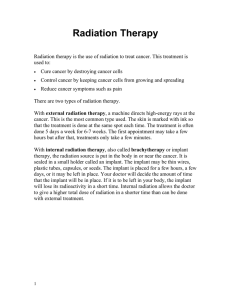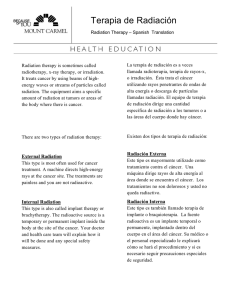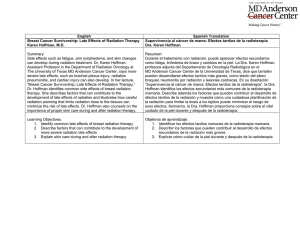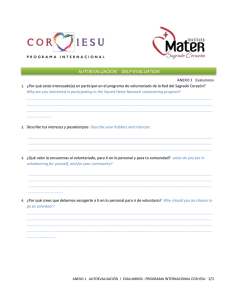Radiation - CancerCare Manitoba
Anuncio
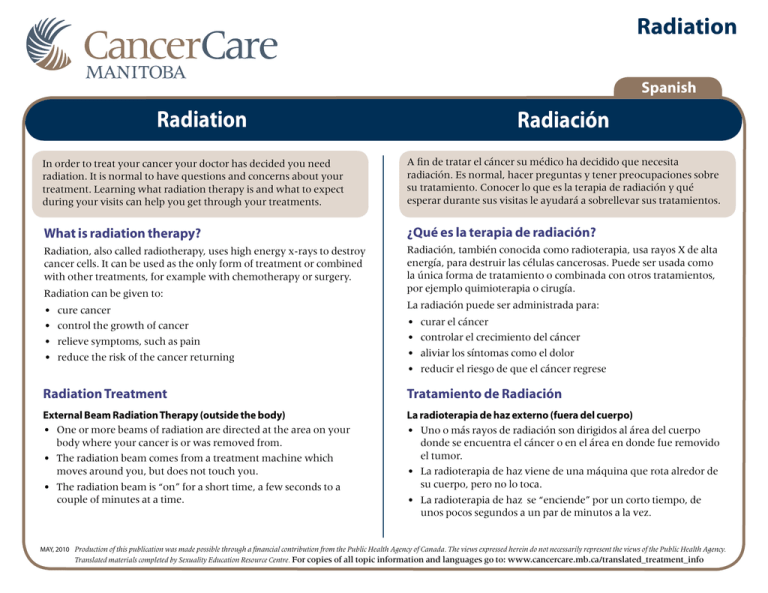
Radiation Spanish Radiation Radiación In order to treat your cancer your doctor has decided you need radiation. It is normal to have questions and concerns about your treatment. Learning what radiation therapy is and what to expect during your visits can help you get through your treatments. A fin de tratar el cáncer su médico ha decidido que necesita radiación. Es normal, hacer preguntas y tener preocupaciones sobre su tratamiento. Conocer lo que es la terapia de radiación y qué esperar durante sus visitas le ayudará a sobrellevar sus tratamientos. What is radiation therapy? ¿Qué es la terapia de radiación? Radiation, also called radiotherapy, uses high energy x-rays to destroy cancer cells. It can be used as the only form of treatment or combined with other treatments, for example with chemotherapy or surgery. Radiación, también conocida como radioterapia, usa rayos X de alta energía, para destruir las células cancerosas. Puede ser usada como la única forma de tratamiento o combinada con otros tratamientos, por ejemplo quimioterapia o cirugía. Radiation can be given to: • • • • cure cancer control the growth of cancer relieve symptoms, such as pain reduce the risk of the cancer returning La radiación puede ser administrada para: • • • • curar el cáncer controlar el crecimiento del cáncer aliviar los síntomas como el dolor reducir el riesgo de que el cáncer regrese Radiation Treatment Tratamiento de Radiación External Beam Radiation Therapy (outside the body) • One or more beams of radiation are directed at the area on your body where your cancer is or was removed from. • The radiation beam comes from a treatment machine which moves around you, but does not touch you. • The radiation beam is “on” for a short time, a few seconds to a couple of minutes at a time. La radioterapia de haz externo (fuera del cuerpo) • Uno o más rayos de radiación son dirigidos al área del cuerpo donde se encuentra el cáncer o en el área en donde fue removido el tumor. • La radioterapia de haz viene de una máquina que rota alredor de su cuerpo, pero no lo toca. • La radioterapia de haz se “enciende” por un corto tiempo, de unos pocos segundos a un par de minutos a la vez. MAY, 2010 Production of this publication was made possible through a financial contribution from the Public Health Agency of Canada. The views expressed herein do not necessarily represent the views of the Public Health Agency. Translated materials completed by Sexuality Education Resource Centre. For copies of all topic information and languages go to: www.cancercare.mb.ca/translated_treatment_info Spanish Radiation Radiación • Each appointment is about 15 minutes. • Most patients receiving external radiation therapy will have a “simulation” appointment. ~ This planning appointment takes 20-60 minutes. ~ You are placed in the treatment position and scans or X-rays are taken of the area to be treated. ~ Felt pen markings or small permanent tattoos are placed on your skin to outline the treatment area. These marks are necessary for the radiation therapists to accurately position you for treatment. • Cada cita toma cerca de 15 minutos. • La mayoría de pacientes que reciben radioterapia con haz externo tendrán una cita de “simulación”. ~ Esta cita de planificación del tratamiento toma 20-60 minutos. ~ Usted es colocado/a en la posición de tratamiento, se toma un Scan o rayos-X del área que será tratada. ~ Se marcará su piel con un marcador permanente o se le colocarán pequeñas marcas de tatuaje para trazar el área de tratamiento. Estas marcas son necesarias para que él/la radioterapeuta pueda administrar el tratamiento con precisión. Internal Radiation Therapy (inside the body) • Also called Brachytherapy. • A tube is inserted into the area of the body affected by cancer. • A radiation source is placed inside the tube and stays in place for 10-20 minutes. • Appointment times are usually two to three hours long. • Only some patients receive internal radiation therapy. Terapia de Radiación Interna (dentro del cuerpo) • También se le llama braquiterapia. • Se introduce un tubo en el área afectada por el cáncer. • Se coloca material radioactivo dentro de un tubo y se deja en el lugar por 10 a 20 minutos. • Las citas son usualmente de dos a tres horas de duración. • Solamente algunos pacientes reciben terapia de radicación interna. MAY, 2010 Production of this publication was made possible through a financial contribution from the Public Health Agency of Canada. The views expressed herein do not necessarily represent the views of the Public Health Agency. Translated materials completed by Sexuality Education Resource Centre. For copies of all topic information and languages go to: www.cancercare.mb.ca/translated_treatment_info Spanish Radiation Radiación Side Effects of Radiation Therapy Efectos Secundarios de la Terapia de Radiación Except for feeling tired, side effects occur only in the area of your body that is being treated with radiation. Everyone can experience side effects differently. Eating well and getting proper rest is important to help you manage them. Possible short term side effects: Excepto por sentirse cansado/a, los efectos secundarios ocurren solamente en el área del cuerpo que ha sido tratada con radiación. Cada persona experimenta los efectos secundarios en forma diferente; para manejarlos mejor, es muy importante comer bien y descansar suficiente. -headaches -hair loss Posibles efectos secundarios a corto plazo: -skin irritation -feeling tired -dolores de cabeza -perdida de cabello -sore mouth and/or throat -difficulty swallowing -irritación de la piel -sensación de cansancio -loss of appetite -nausea -ulceras de la boca o garganta -dificultad al tragar -vomiting -swelling -perdida de apetito -náusea -productive cough -diarrhea -vómito -hinchazón -bladder irritation -tos productiva -diarrea When you start radiation your therapist will tell you how to take care of the treatment area and how to manage any side effects. It is important to tell your therapists, nurse and doctor about all side effects. -irritación de la vejiga Cuando comience la radioterapia, su terapeuta le hará saber cómo tomar cuidado del área de tratamiento y cómo manejar los efectos secundarios. Es muy importante hacerle saber a su terapeuta, enfermera y doctor sobre todos los efectos secundarios que usted experimente. MAY, 2010 Production of this publication was made possible through a financial contribution from the Public Health Agency of Canada. The views expressed herein do not necessarily represent the views of the Public Health Agency. Translated materials completed by Sexuality Education Resource Centre. For copies of all topic information and languages go to: www.cancercare.mb.ca/translated_treatment_info Spanish Radiation Radiación Radiation Therapy Facts Datos Sobre la Radioterapia • All radiation treatments are given between Monday and Friday at CancerCare Manitoba, 675 McDermot Avenue in Winnipeg. • Some patients may only receive one treatment; others receive as many as 35 or more treatments. This will be decided by your doctor. • Sometimes a shell or cast may be needed for your treatment. This will be placed over the part of your body that is receiving radiation. It will help you to stay in position during your treatment. • Radiation therapists can be male or female. All are trained professionals who care about your well being. • It is necessary to expose the area where you will be treated so that the therapists can see the marks or tattoos that help them place you in the treatment position each day. Every effort will be made to keep you comfortable and maintain your privacy. • During the radiation treatment you are alone in the treatment room. The therapists can see and hear you. You are safe. • You can breathe normally when you are being treated. • You can not feel or see radiation. • Radiation Therapy contact phone number: 787-2585 or toll free at 1-866-561-1026. • Todos los tratamientos son administrados entre lunes a viernes en el CancerCare Manitoba, 675 McDermot Avenue en Winnipeg. • Algunos pacientes tal vez recibirán solamente un tratamiento; otros reciben tantos como 35 o más tratamientos. Esto lo decide el médico. • Algunas veces necesitará una concha o yeso para su tratamiento. Esto se colocará sobre la parte de su cuerpo que recibe radiación; el cual le ayudará a mantenerse en posición durante su tratamiento. • El radioterapeuta puede ser hombre o mujer. Ambos sexos han sido entrenados profesionalmente y ellos se preocupan por su bienestar. • Es necesario exponer el área en donde se dará el tratamiento para que él/la terapeuta pueda mirar las marcas o tatuaje que le guiarán a colocarle en la posición que se usará durante el tratamiento diario. Se tomaran las medidas necesarias para ponerlo/a cómodo/a y mantener su privacidad. • Durante el tratamiento de la radioterapia, usted estará solo/a en el cuarto de tratamiento. El/la terapeuta puede verle y escucharle. Usted estará seguro/a. • Usted puede respirar normalmente durante el tratamiento. • Usted no puede sentir o mirar la radiación. • Los números de contacto del departamento de Radioterapia son: 787-2585 o la línea gratuita 1-866-561-1026. MAY, 2010 Production of this publication was made possible through a financial contribution from the Public Health Agency of Canada. The views expressed herein do not necessarily represent the views of the Public Health Agency. Translated materials completed by Sexuality Education Resource Centre. For copies of all topic information and languages go to: www.cancercare.mb.ca/translated_treatment_info
